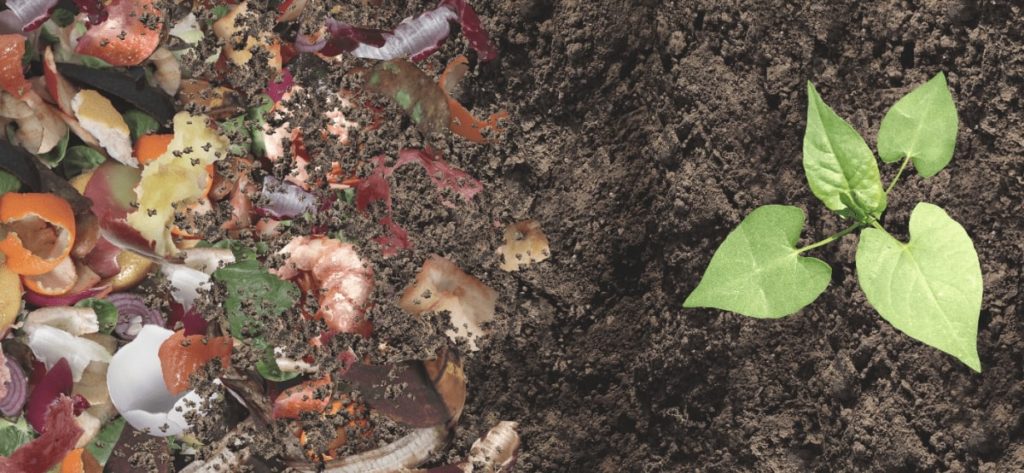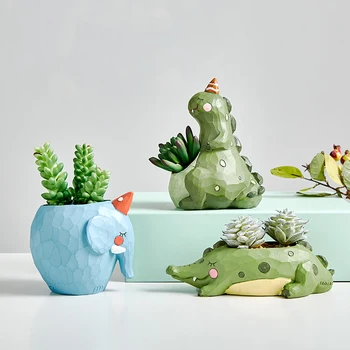Composting is an eco-friendly way to maintain a healthy garden by using a variety of organic material items. You can use many natural items from your yard and home, including kitchen and food scraps, grass clippings, plant materials, yard waste, and other types of organic waste.
Organic material is a great way to reduce kitchen waste and improve the quality of your garden’s soil and plants. Compost is the process of breaking down organics. The more organic matter you add to the soil, the better value you’ll notice in the health and development of your vegetation.
Here is a quick definition, with a breakdown to follow: Compost is a thick, moist, and crumbly, dark, paste-like material that is the result of the controlled aerobic biodegradation, which is known as composting of organic material. This part of the soil contains all the recycled nutrients, which allows it to be used again.
You’ll find that compost tends to be much darker and moister than other soil, and this is due to the high number of nutrients and organisms thriving in this topsoil. This natural ecosystem functions through aerobic biodegradation with oxygen to break down organic materials with living organisms.
Compost is the result of natural, organic waste that decomposes into rich, black soil that’s rich in nutrients. This process begins by collecting as many organic matters and waste from kitchen scraps and food peelings to yard waste, grass clippings, and small twigs.

Indoors, a compost bin collects all the food scraps and kitchen waste, accumulating quickly after peeling vegetables and preparing meals over a few days or a week. A small bin is ideal for a small home, while a medium to large compost bin is perfect for regular family meals and commercial kitchens.
A larger green bin or compost container is ideal for collecting a compost pile from small and shredded branches, grass clippings, plant, and yard waste in the yard. The Indoor kitchen scraps are regularly emptied into the outdoor compost tumbler, which requires regular moisture to break down naturally for the composting process.
Composting requires a regular supply of oxygen because the organisms involved are mainly aerobic. This means they require oxygen to live and break down substances. The organisms use up organic materials to produce energy, known as carbon, and build proteins through nitrogen.
These cellular processes help break down organic structures such as animal feces and plants into smaller pieces and compost. These materials produce water vapor, CO2, and heat. Fermentation through anaerobic organisms is an integral part of the composting process, which breaks down more complex structures of plants and organics to help soften them into the soil.
Compost is a complex process. This stage involves thousands of tiny organisms that are involved in the composting process. These organisms include microbes, fungi, and actinomycetes, unique bacteria that resemble fungi and invertebrates.
Vermicomposting occurs through smaller animals or organisms such as earthworms and insects. They play a vital role in the composting process, with some organisms break down cellulose or hemicellulose and others offer more specific processing benefits.
The thermal phase happens in three stages: the activation stage, thermophilic step, and maturation. In the beginning, there was a substantial increase and growth of mesophilic or heat-based microorganisms and thermophilic or high-based fungi.
During this phase, amino acids are quickly consumed to increase heat, which leads to the next stage of thermophilic microorganisms. These bacteria, actinomycetes, and fungi play an essential role in composting at this stage in the composting process.
At this phase, where high heat is produced, around 158 degrees Fahrenheit, plant wall materials such as hemicellulose and cellulose are broken down. The compost is naturally sanitized, making it safe for humans and plants.
In the final phase, leftover resources are further broken down and depleted to produce “black gold” soil high in nutrients.
Several main parts make up the composting process, which includes airflow (oxygen), a collection of organic matter, bacteria, and moisture. All these components are required to make the compost process work successfully.
The composting process slows down if the organic matter is too dry, making moisture essential for turning organic matter into a successful compost pile.
Your compost pile consists of more than plant material and food scraps. You can also add animal manure and dead leaves raked during autumn, dead plants, and other items that are considered organic and break down into the compost pile. The green items (plant and food scraps) and brown items (animal manure, dead leaves) play a role in the composting process.
Imagine having a recipe that required only four ingredients to make the most fabulous dish you’ve ever had. Even better, that recipe allowed for tons of substitutions. If you didn’t have one thing, you could substitute something else. And then, it didn’t require precise measurements or even a specific temperature or cooking time.
Making compost is that simple—a four-ingredient recipe for the most awesome amendment to make everything growing in your garden grow better. The four ingredients: Air, Water, Carbon (browns), and Nitrogen (greens).
Microorganisms are a vital part of breaking down organic materials during aerobic composting. You can improve this process by adding earthworms, insects, and other tiny organisms that majorly transform the pile into finished compost.
Microorganisms can’t live without it. It’s that simple. Airflow throughout the compost pile is vital to keeping the process moving towards a finished compost. You’ll need to regularly turn or mix the organic matter to aid the breakdown in organic materials.
The bacteria flourish in an oxygen-rich environment when the perimeters of the compost pile are raked into the center. All the organic material is equally distributed for equal composting.
Another benefit of turning the composting pile is reducing the odor or settling pools of water or material that can slow down turning your organics into finished compost. It’s essential to turn your compost regularly (at least once every two weeks) to keep the microorganisms working to transform organics into healthy compost for the soil.
Your compost heap should include a lot of moisture, which is easy if you collect rainwater or there is frequent precipitation. It’s essential to keep the compost bin balanced in wetness. If you notice too much water or pools of water, adding more brown material can help absorb the excess wetness.
The organisms in your compost must contain moisture to survive. It’s also imperative for maintaining chemical reactions that feed nutrients to microorganisms.
A simple way of knowing is to take a handful of compost and squeeze it. If water drains from your hand, it’s too wet. Conversely, if it does not feel moist or bind together when squeezed, it’s too dry.
As you turn the compost, the bacteria work to break down the materials, a process that releases heat and increases the efficiency of this transformation. You can add different plant and organic materials and soil and finished compost to improve the composting.
As you continue to turn, add materials, and keep the compost heap moist, it’s key to add green and brown organics in even portions, to maintain the balance between oxygen and nitrogen.
Carbon (brown) organics are easily found in your kitchen and yard. Common examples of brown waste ingredients include dried leaves, small twigs, leaves, coffee grounds, shredded paper and newspapers, paper towel rolls, and brown paper bags.
The dry, brown organic matter supplies carbon to the compost bin while the plant life and green materials contribute nitrogen. Ideally, you’ll want to have equal parts green and brown organics, to facilitate the composting process.
Common examples of green waste include fresh grass and plant clippings, and food scraps such as fruit and vegetable peels if your pile isn’t green enough, either because you don’t have enough plant waste or kitchen scraps add to your outdoor compost bin.
A compost heap with low green materials can boost fertilizer to add nitrogen into the organic matter and improve composting.
It’s also crucial to chop or shred branches, twigs, and large items, so they can be evenly spread to mix the carbon and nitrogen equally throughout the compost tumbler.
Recommended reading: What Can You Compost?
The length of composting depends on a few criteria, including the type of organic materials added to the compost, the volume, the moisture and bacteria, and how well it is maintained. The ideal size of a compost pile is a cube size of approximately four or five feet.
This size and dimensions allow the materials to be easily turned and maintained so that the center is heated and efficiently “burns” or breaks down the organic materials and waste.
This process occurs during the beginning stages of composting when the organic materials that are easy to break down are quickly metabolized. There must be a steady flow of oxygen and moisture during this stage, as this helps heat the materials and release gases.
Compost requires two types of bacteria to break down: aerobic and anaerobic microorganisms. Anaerobic bacteria don’t require oxygen, and they play an important role in processing outdoor organics and food waste into soil high in nutrients.
Earthworms and small insects are a strong component in the breakdown of organic waste. When these organisms process materials through their digestive system, it becomes further processed and infused with microflora and internal juices from the intestines of the microorganisms. This stage is known as vermicomposting.
An electric composter uses heat, pulverization, and aeration to chop down food waste and organic waste to speed up the composting process. This system helps reduce the size of the organics and is used indoors in a compact size. It’s ideal for kitchen countertops.
Once your compost pile is ready, you can add it by distributing evenly to your garden, whether you have a few plant pots and a small flower garden or an extensive vegetable garden. You’ll find a good compost that offers rich soil full of nutrients that will enhance the quality of your plants, from the compost pile to healthy soil in the garden.





We provide a platform supported by gardening enthusiasts to share unique experience and knowledge.
We’ve pledged 5% of sales to the program which help more families have opportunity to have garden.
Every action we make has an impact on planet. Learn more about Million Compost Movement.
Join facebook community to connect, share passion and get support when you need.
Keep in mind that we may receive commissions when you click our links and make purchases. However, this does not impact our reviews and comparions. We try our best to keep things fair and balanced, in order to help you make the best choice for you.
As an Amazon Associate, we earn from qualifying purchases.
Sign up for gardening tips, activism awareness, exclusive offers and more!
© Garden Guidepost

Gardening tips, activism awareness, exclusive offers and more!